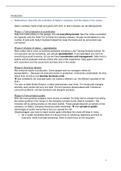Introduction
1. Salleramics: describe the evolution of Sally’s company, and the steps in her career.
Sally’s company starts small and grows with time. In total 4 phases can be distinguished:
Phase 1: From production to coordination
Sally first made pottery in the garage, she did everything herself. Next the orders exceeded
her capacity and she hired Tim (a friend from pottery classes), his pay would depend on the
number of pots sold. Sally’s husband helped her keep the books and an accountant was
contracted.
Phase 2: Division of labour – specialisation
More orders led to more co-workers/assistants including a Job Training Scheme trainee. As
not everyone can do everything, you will get specialization. If you specialize you can’t do
everything yourself anymore, so you will need coordination and management. Sally hired a
pottery school graduate and two others who had a little experience. Sally spent more time
with customers and the accountant and less time in the studio.
Phase 3: Structure: division
Not everyone works in production. Some people work as managers others do
transportation… Because not everyone works in production, it becomes complicated. So they
adjust their structure and develop business units.
➔ less complexity (for example each unit makes a different car, the different faculties of the
KUL).
Tim was re-titled Studio Director, a sales administrator was hired, Tim introduced changes
whereby each worker did only one task. The firm became divisionalised with 3 divisions;
consumer products, contract products and designer products.
Phase 4: From private to public
With the more growing company more money is needed. So Sally had to change from being
the owner (putting in her money in the company/ private) to the need of investors. The
investors will by selling shares on the stock market. These people become co-owners of the
company, so Sally’s company becomes public ownership. ➔ from private to public.
Advantages of public ownership is that you spread the risk.
Disadvantages: you have to reach certain goals otherwise the share will drop in value.
So in public ownership there is a strong focus on achieving objectives and less on
long term, while in private ownership, there is more focus on the long term
1
, CLASS ANSWER:
She starts and does everything herself, she becomes successful what happens, she hires
somebody, what happens when you hire employees, tell the person what to do, it evolves,
small part of the job but after a while more and more employees, you end up doing nothing
but coordination, she becomes a manager, does not participate in production, you want to
improve the organisation, you start coordinating, what else changes if you get more and
more people in the organisation, we all know how to do the different tasks from the beginning
to the end, divide the work, you start specialising, people specialise in certain tasks, to be
more efficient, the more repetitive the task you do, the better you become and you can
produce more, never efficient in anything if you do all this yourself, very wealthy because we
are all extremely good in a couple of things, the more people are specialised the more you
need coordination!! Somebody needs to tell you start with that because later on that person
comes to do that, the more people you have, you need more coordination and more
specialisation, how to solve this complexity? Different divisions were made, you split it up,
reduce the complexity, not supposed to understand what happens in the other divisions, try
to divide and create divisions.
Ownership: who owned the company when Sally started, why? Everything that was in the
company was paid by Sally, then the organisation grows, bigger company with 10
employees, who owns the company? Still Sally, why? Sha had little money when she started,
company grew a lot, could grow bec with every piece of product she sold, money was
coming in, later on sally started selling parts of the company, not enough money to invest to
keep on growing so you need people that invest and that is why she sells parts of the
company, suppose for whatever reason she goes bankrupt, if she fully owns the company
she lost everything and all the effort, risk is divided in two if she has another companion, an
investor: publicly owned, if it is this way, she can put money on her private account and not
only on the account of the company , and she does not loses everything, stock market, you
need access for money to grow and the risk you want to reduce the risk (shares = aandelen).
2. What is the task of a manager in a world full of specialists?
It is important that you have people next to specialists who can coordinate and who can bring
innovations to a wide audience. This is the task of a manager. Innovations have an impact only
if they reach a large audience and this requires management. The essence of management is
not to supervise others, it is not about economics and engineering. It is very much about
people. Because the world economy becomes more knowledge-based, work will grow more
specialized and complex. This led to the paradox: The more highly educated and specialized
we become, the more we need other people to perform. This led to the essence of
management: turning complexity and specialization into performance. There is a need of
organization that makes the work individuals do productive and to make organizations work.
Actually, management is everyone’s business. Without some sort of organization, nothing
would get done. So, the fundamental job of management is to create value for customers by
helping people to be more productive and innovative in a common effort.
So managements’ real business is building organizations that work. Underneath all the theory
and the tool, underneath all the specialized knowledge, lies a commitment to performance that
has powerfully altered our economy and our lives. Without some sort of organization nothing
would get done.
2
, A couple of important tasks of a manager are:
▪ To organize how people work together so you will get the best result out of it
▪ Planning
▪ Create structure in an organization
▪ Create efficiency
▪ Control the finances
3. What are the 3 types of organisations that exist in
society?
Any good society is based on three pillars
1. Plural sector (social)
a. Organization that are neither public/private
i. Belong to everyone (cooperatives
…), no one (foundations, clubs,
religious orders, NGO …)
ii. Are not-for-profit, non-governmental
b. They also make profit, but the profit stays in the company
c. Deliver professional services
d. Non-profit organisation, not government owned, not private owned, don’t belong
to shareholders, belong to everyone
2. Private sector (economic)
a. Organizations that create for-profit economic activity (from single entrepreneurs
to multinational corporations)
b. Commercial sector
c. For-profit & non-governmental
d. Deliver goods and services
e. To make money, to make a profit, very dynamic, move fast, try to develop new
products and services
3. Public sector (political)
a. Organizations administered by governments on behalf of the public
(governments at all levels)
b. Deliver safety and infrastructure
c. Define the rules that we must follow and to make sure that they are followed
A democratic society consists of the 3 sectors in balance. There needs to be a balance
between these societies.
4. Give a synonym for the for-profit sector
Private sector (economic)
5. Give a synonym for the government sector
Public sector (political)
3
,6. Give one or more synonyms for the not-for-profit sector (non-profit sector) (examen
2019)
Plural or social sector
→ Relevance? To keep it accessible for everyone.
7. What are the typical roles of each of the sectors in society
1. Public sector (political)
Organizations administered by governments on behalf of the public so they need
to deliver safety and structure
Governments at all levels (so there are rules/laws, taxes … that are the same for
everybody. A well-functioning government is crucial for a well-functioning society)
2. Private sector (economic)
Organizations that create for-profit economic activity so they need to deliver
goods and services
From single entrepreneurs to multinational corporations
3. Plural sector (social)
Organization that are neither public/private (non-profit) that need to deliver
professional services
Belong to:
o Everyone (cooperatives …)
o No one (foundations, clubs, religious orders, NGO …)
Are not-for-profit: they can make profit, but this stays in the company
A democratic society consists of the 3 sectors in balance.
8. Why do people work together? Why create organisations?
We create organizations to accomplish ends none of us could achieve acting alone. If not, it
would be simpler, cheaper and more flexible to work alone.
9. Why do we need management in general?
Because people that work together need coordination
10. Why do we need management specifically in the healthcare sector?
We need management specifically in the healthcare sector to reduce the growth in
healthcare costs.
4
, Chapter 1: value creation
11. Shareholder mindset: which do you prefer (USA versus Europe), and argue why.
(JULIE) maybe slide 14 ppt 2.1
▪ Shareholder mindset USA:
o It’s a purely financial approach, which can have a large social cost so it is
irrespective of social damage.
o Maximize value only for shareholders (shareholder must always come first)
o Goal of management: purely and simply maximizing the shareholder value
and make more profits
• Companies are seen as an investment
• You will do everything to make more profit, even if it means you have
to fire 100 employees to reach it (great social damage) if your
company is healthy
▪ Shareholder mindset Europe:
o Create value for different stakeholders and not only for shareholders
o Maximize value for different groups of stakeholders
o Management has broader obligations to society as a whole
• If a company is healthy and a change would damage the society, you
leave it like that, and you don’t change the company just to make more
profit. The extra profits made by shutting down a company or firing
people doesn’t outweigh the cost of this company or these people
losing their jobs.
Opinion/prefer: I prefer the Europe mindset because if you focus too much on only your
shareholders, your employees will become demotivated, you can lose insight in what the
customer wants and by that lose their interest in your product. The stakeholder is at least
even important as shareholder value. The focus on society is also better: don’t make profit
with the risk of damaging people. The USA is to capitalistic. It fails to take the safety needs of
people into account. It’s not just about the money. We should consider the lives of people as
value as well.
12. What is the difference between selling and marketing? OK ppt 2
Selling: convincing customer to buy whatever you make
= inside-out perspective: start with what you make, you price it based on what it cost you and
then you sell it to a customer
= make-and-sell model
Marketing: understanding what customers value so you can satisfy their needs. It is the
customers (and not producers or providers) that determine value.
= outside-in perspective: start with what the customer wants and with how much she or he is
willing to pay for it and this determines both what you make and how much you can spend
making it
= sense-and-response model
5





